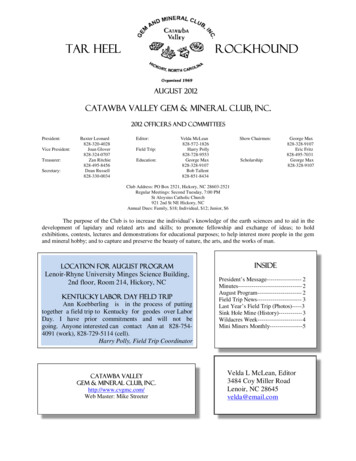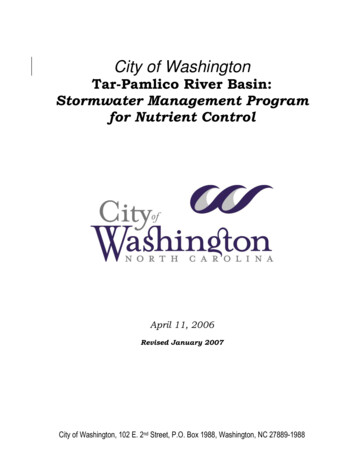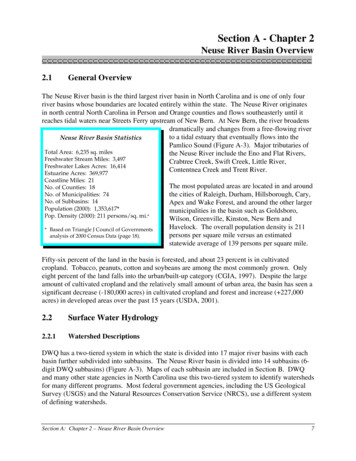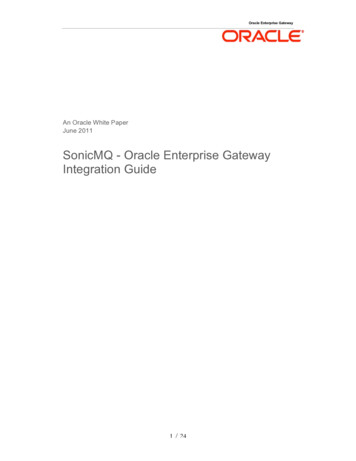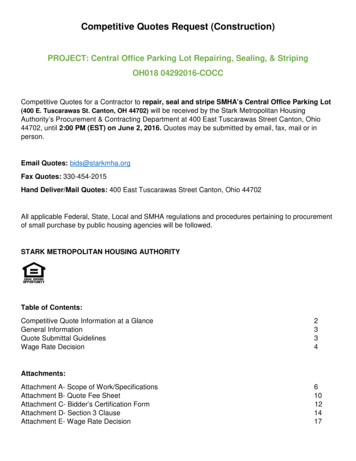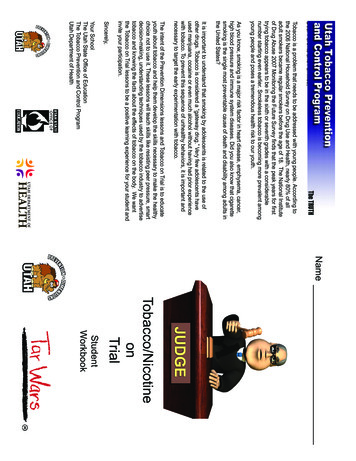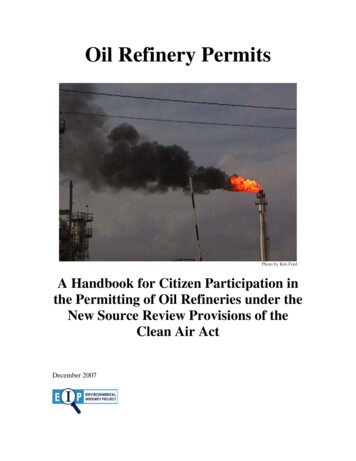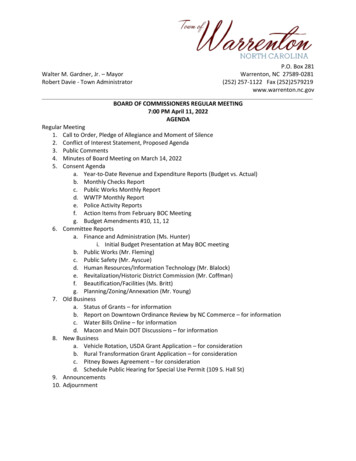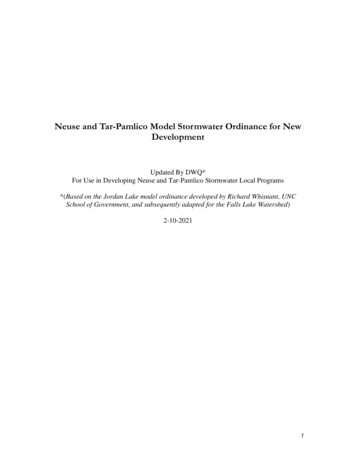
Transcription
Neuse and Tar-Pamlico Model Stormwater Ordinance for NewDevelopmentUpdated By DWQ*For Use in Developing Neuse and Tar-Pamlico Stormwater Local Programs*(Based on the Jordan Lake model ordinance developed by Richard Whisnant, UNCSchool of Government, and subsequently adapted for the Falls Lake Watershed)2-10-20211
Revision historyOriginal Draft Falls Ordinance dated 2/15/11 used as foundation of documentVer. 4.0 Revised model ordinance to make to incorporateFalls Lake Requirements- Updated cover page- Removed references to Falls Session law 2009-26 and 2009-484 from Section 102- Removed reference to General Assembly Action in Section 103- Added 1/2 acre and 12,000 sq/ft land disturbance thresholds to Section 105 (B)- Updated state & federal comment box on page 12- Updated Section 302 (A) and (B) with Falls lake nutrient targets and percent reduction objectives- Revised Section 303 to remove reference to TSS requirements- Revised Section 205 to incorporate Falls onsite treatment requirements- Updated comment box in Section 308- Updated comment box in Section 501Neuse and Tar-Pamlico New Stormwater Rule Requirements – edits January 2021-Major modifications in Section 3: Standards for Neuse and Tar-Pamlico developmentrequirement projects-Major modifications in Section1: Applicability and Jurisdiction for Neuse and Tar-Pamlicoapplicability and exclusionsChanges in State Stormwater Rules – edits January 2021-Major modifications in Section 4: Maintenance to align with new requirements-Smaller modifications throughout to have consistent references to “engineered stormwatercontrols” (assumed preferred term), Minimum Design Criteria, definitions, standards in Rule.1003, and other miscellaneous issuesMerger of 153A and 160A into 160D, changes to NCGS 143-214.7, WSW – edits January 2021-General Statutes and Rule references reviewed throughout in order to point to correct statutes-Major modifications to variance and enforcement sections to adapt to changes in WSW Rules,160D, and other regulations, and that Neuse and Tar-Pam do not specify any variance orenforcement procedures-“Redevelopment” changed to “expansion of development” throughout, definitions updated,and additional explanation of project area and existing BUA where appropriateChanges for Neuse/Tar-Pamlico specific guidanceExample text was added for a method of setting up BUA tracking and more flexible methodsto manage development expansion.2
Table of ContentsNeuse and Tar-Pamlico Model Stormwater Ordinance for New Development . 1SECTION 1: GENERAL PROVISIONS . 8xx-101Title . 9xx-102Authority . 9xx-103Findings. 9xx-104Purpose . 10xx-105Applicability and Jurisdiction . 12(A)General . 12(B)Exemptions . 12(C)No Development or Expansion Until Compliance and Permit . 13(D)Map. 13xx-106Interpretation . 14(A)Meaning and Intent. 14(B)Text Controls in Event of Conflict . 14(C)Authority for Interpretation . 14(D)References to Statutes, Regulations, and Documents . 14(E)Computation of Time. 14(F)Delegation of Authority . 15(G)Usage . 15(H)Measurement and Computation . 15xx-107Design Manual . 15(A)Reference to Design Manual . 15(B)Relationship of Design Manual to Other Laws and Regulations . 16(C)Changes to Standards and Specifications . 16(D)[Amendments to Design Manual] . 16xx-108Relationship to Other Laws, Regulations and Private Agreements . 16(A)Conflict of Laws . 16(B)Private Agreements . 17xx-109Severability . 18xx-110Effective Date and Transitional Provisions . 18(A)Effective Date . 18(B)Final Approvals, Complete Applications . 183
(C)Violations Continue . 18SECTION 2: ADMINISTRATION AND PROCEDURES . 19xx-201Review and Decision-Making Entities . 19(A)Stormwater Administrator . 19xx-202Review Procedures . 20(A)Permit Required; Must Apply for Permit . 20(B)Effect of Permit . 20(C)Authority to File Applications . 20(D)Establishment of Application Requirements, Schedule, and Fees . 21(E)Submittal of Complete Application . 22(F)Review . 22xx-203Applications for Approval . 23(A)Concept Plan and Consultation Meeting . 23(B)Stormwater Management Permit Application . 24(C)As-Built Plans and Final Approval . 25(D)Other Permits . 25xx-204Approvals . 25(A)Effect of Approval . 25(B)Time Limit/Expiration. 25xx-205Appeals . 26(A)Right of Appeal . 26(B)Filing of Appeal and Procedures . 26(C)[Review by Superior Court] . 27SECTION 3: STANDARDS . 28xx-301General Standards. 28xx-302[Built Upon Area Standards] . 28xx-303Nitrogen and Phosphorus Loading Rate Targets . 29xx-304Nitrogen and Phosphorus Standard is Supplemental . 29xx-305Control and Treatment of Runoff Volume. 30xx-306Methods to Meet Nutrient Control Requirements . 30xx-307Use of Permanent Nutrient Offset Credits . 30xx-308Evaluation of Standards for Stormwater Control Measures . 31(A)Evaluation According to Contents of Design Manual . 314
(B)Determination of Adequacy; Presumptions and Alternatives . 31xx-309Dedication of BMPS, Facilities & Improvements . 32xx-310Variances . 32SECTION 4: MAINTENANCE . 34xx-401General Standards for Maintenance . 34(A)Function of Engineered Stormwater Controls As Intended . 34(B)Annual Maintenance Inspection and Report . 34xx-402Operation and Maintenance of Engineered Stormwater Controls . 35(A)Operation and Maintenance Plan. 35(B)Operation and Maintenance Agreement . 35(C)Special Requirement for Homeowners’ and Other Associations . 36xx-403Inspection Program. 37xx-404Performance Security for Installation and Maintenance . 38(A)May Be Required . 38(B)Amount. 38(C)Uses of Performance Security . 39xx-405Notice to Owners . 40(A)Deed Recordation and Indications On Plat . 40(B)Signage . 40xx-406Records of Installation and Maintenance Activities . 40xx-407Nuisance . 40xx-408Maintenance Easement. 40SECTION 5: ENFORCEMENT AND VIOLATIONS. 42xx-501General . 42(A)Authority to Enforce . 42(B)Violation Unlawful . 42(C)Each Day a Separate Offense . 42(D)Responsible Persons/Entities. 42xx-502Remedies and Penalties . 43(A)Remedies . 43(B)Civil Penalties . 45(C)Criminal Penalties. 45xx-503Procedures . 455
(A)Initiation/Complaint . 45(B)Inspection . 45(C)Notice of Violation and Order to Correct . 45(D)Extension of Time . 46(E)Enforcement After Time to Correct . 46(F)Emergency Enforcement . 46SECTION 6: DEFINITIONS . 47xx-601Terms Defined . 47Built-upon area (BUA) . 47Department . 47Design Manual. 47Developer . 47Development . 48Development approval . 48Division. 48Engineered stormwater control . 48Land disturbing activity . 48Larger common plan of development or sale . 48Load. 48Loading rate . 48Major variance . 48Minimum Design Criteria . 49Minor variance . 49Nitrogen . 49Nutrient, Nutrients . 491-year, 24-hour storm . 49Outfall . 49Owner . 49Parcel . 50Permanent nutrient offset credits . 50Person . 50Phosphorus . 50Primary SCM . 506
Project . 50Redevelopment . 50Runoff treatment . 50Runoff volume match . 50Site Plan . 50Stormwater . 50Stormwater system. 50Subdivision. 50Substantial progress. 51Total nitrogen . 51Total phosphorus . 517
SECTION 1: GENERAL PROVISIONSComment: Context for this model ordinance—This model ordinance, previously developed forimplementing Jordan Lake Stormwater Rules and Falls Lake Rules, has been extensively reviewed andupdated for use as guidance for local governments in the Neuse and Tar-Pamlico watersheds to develop ormodify their own local ordinances for the implementation of the Neuse and Tar-Pamlico Stormwater Rules(15A NCAC 02B .0731 and .0711 respectively), effective April 1, 2020. We provide this model ordinancedeveloped for another watershed since most of the regulatory structure of a local stormwater ordinance isexpected to be similar across the State. The document has been reviewed for elements that implementnutrient and stormwater requirements, changes to statutes and Rules, modifications to comments andguidance, changes in definitions and uses of terms, and consistent terminology throughout.NOTE: Some methods to implement or enforce Neuse or Tar-Pamlico Stormwater Rules that areconsidered Best Practices may not be represented in this model ordinance. Local governments shouldreview their anticipated Rule implementation approaches to determine whether this Model Program orportions of it adequately cover all needed authorities.The Falls model ordinance was developed in 2011, prior to changes in NC General Statutes that combinezoning regulations for cities and counties into a single Chapter 160D. This document has been reviewedfor elements where we suspect changes to zoning regulations in NCGS 160D have an effect, but localgovernments should coordinate with their Planning departments to verify that all 160D elements areupdated.All ordinances implementing the Neuse or Tar-Pamlico stormwater rules for new development, includingordinances that adopt this model with modifications, must be reviewed and approved by theEnvironmental Management Commission or, through delegated authority, the Division of Water Resourcesof the North Carolina Department of Environmental Quality before Neuse or Tar-Pamlico stormwater rulecompliance is assured.Many jurisdictions already have stormwater programs as a part of their development review process—someunder Phase II of the federal stormwater program, others as part of the state Water Supply WatershedProgram or other state stormwater programs. Such jurisdictions have the option to adopt this model, orsimilar language, with modifications as needed for implementing Neuse or Tar-Pamlico Stormwater Rules,but it is more likely they will wish to mesh the parts of this model that are new and different (mainly thestandards for nutrient loading) with their existing stormwater review process. Either approach can work.Also, to the greatest extent possible, this model was originally written to match existing regulations forPhase II and Water Supply Watersheds.Comment: Format--Throughout this model ordinance, the bold underlines serve as prompts where textthat is appropriately customized for the locality should be inserted or the inapplicable text removed. Forexample, where “name of governing board” is indicated in the blank, the name of the local governing body– for example, “Tarheelville City Council” or “Dogwood County Commission” – should be inserted.Commentary from the drafter of the model ordinance is placed in boxes such as this. These commentsshould be removed from the ordinance text actually adopted; they are not part of the ordinance itself.Optional provisions are provided throughout this document and are intended to address the diverse needs oflocal government depending on characteristics such as population, financial resources, location in thewatershed and staffing resources. Optional provisions are shown in [brackets] and generally areaccompanied by some explanation in the commentary.Defined terms are shown in italics. The definitions section of the ordinance is at the end.8
Footnotes give information on the original source of the text language. Note that changes may have beenmade in the source language to better match North Carolina’s needs.xx-101 TITLEThis ordinance shall be officially known as “The Name of Watershed Stormwater Ordinancefor New Development.” It is referred to herein as “this ordinance.”xx-102 AUTHORITYThe name of governing board is authorized to adopt this ordinance pursuant to NorthCarolina law, including but not limited to Article 14, Section 5 of the Constitution of NorthCarolina; [name of municipal charter, if relevant]; North Carolina General Statutes Chapter143-214.7 and rules promulgated by the Environmental Management Commission thereunder;Chapter 143-215.6A; Chapter 153A-454; Chapter 160A, Chapter 160D, §§ 174, 185, 459 and[cite any special legislation applicable to the specific local government]. [; as well as Chapter113A, Article 4 (Sedimentation Pollution Control)][; Article 21, Part 6 (Floodway Regulation)];[;Chapter 143-214.5, Water Supply Watershed Protection][; Chapter 160A, Article 19(Planning and Regulation of Development); Chapter 153A, Article 18].Regarding this section which recites authority for this ordinance:Some jurisdictions may wish to integrate this ordinance with a local erosion and sediment controlordinance, in which case adding the reference to Chapter 113A is appropriate.Some jurisdictions may wish to integrate this ordinance with existing floodway regulations, in which caseadding the reference to Chapter 143, Article 21, Part 6 is appropriate.Chapter 143-214.5 is appropriate if the jurisdiction is also administering and is integrating this ordinancewith a water supply watershed protection program. Note that the water supply watershed program, erosionand sediment control, and floodway regulations are appropriate for integration with Neuse or Tar-Pamlicostormwater controls, but each of these programs has particular requirements that are not covered in thismodel ordinance.Local governments that anticipate including a program of open space acquisition as part of their stormwaterprogram should include a reference to statutory authority for that function here as well (Article 19, Part 4,Chapter 160A, as well as N.C.G.S. 160A-372, and N.C.G.S 160D-501).Jurisdictions that are adopting this ordinance as part of a land use ordinance or unified developmentordinance should include a reference to statutory authority for planning and regulation of development(N.C.G.S. 160D Article 2, 3, 4), including particularly but not limited to N.C.G.S. 160D-404(enforcement), G.S. 160D Article 8 (subdivision), and N.C.G.S. 160D Article 7 (zoning). In addition, whenadopting this ordinance as part of land use regulations, local governments should follow the standards foradoption/amendment of such ordinances set out in N.C.G.S. 160D Article 6.xx-103 FINDINGSIt is hereby determined that:Development alters the hydrologic response of local watersheds and increases stormwater runoffrates and volumes, flooding, soil erosion, stream channel erosion, nonpoint and point sourcepollution, and sediment transport and deposition, as well as reducing groundwater recharge;9
These changes in stormwater runoff contribute to increased quantities of water-bornepollutants and alterations in hydrology that are harmful to public health and safety as well asto the natural environment; andThese effects can be managed and minimized by applying proper design and well-plannedcontrols to manage stormwater runoff from development sites.Further, the Commission has identified the Name of Watershed Estuary, as nutrient sensitivewaters; has identified all or a portion of the estuary as impaired waters under the federalClean Water Act due to exceedances of the chlorophyll a standard; and has promulgatedrules (the “Name of Watershed Rules” to reduce the average annual loads of nitrogen andphosphorus delivered to the estuary from all point and nonpoint sources of these nutrientslocated within its watershed, including stormwater from new development in this jurisdiction;Therefore, the name of governing board establishes this set of water quality and quantityregulations to meet the requirements of state and federal law regarding control of stormwaterrunoff and discharge for development.xx-104 PURPOSEThe purpose of this ordinance is to protect, maintain and enhance the public health, safety,environment and general welfare by establishing minimum requirements and procedures tocontrol the adverse effects of nitrogen and phosphorus in stormwater runoff and nonpoint andpoint source pollution associated with new development in the watershed of the Name ofWatershed estuary. It has been determined that proper management of construction-relatedand post-development stormwater runoff will minimize damage to public and private propertyand infrastructure; safeguard the public health, safety, and general welfare; and protect waterand aquatic resources.Commentary: The locality adopting the ordinance may wish to supplement the objectives included below,depending on the nature of its stormwater program and specific local needs. This list is a general set ofobjectives to reduce the impacts of post-development stormwater runoff quantity and quality from landdevelopment activities. Not all items may be applicable to your jurisdiction, More specific objectivesmight be included by the locality adopting the ordinance based upon a watershed management plan,impervious surface targets, the findings of a watershed assessment or study, a local water quality problemor Total Maximum Daily Load (TMDL) requirement.This ordinance seeks to meet its general purpose through the following specific objectivesand means:(1) Establishing decision-making processes for development that protects theintegrity of watersheds and preserve the health of water resources;(2) Requiring that new development not exceed export targets for nitrogen andphosphorus in stormwater runoff for the watershed through site layout, engineeredstormwater controls, or permanent nutrient offset credits;(3) Establishing minimum post-development stormwater management standards anddesign criteria for the regulation and control of stormwater runoff quantity andquality;10
(4) Establishing design and review criteria for the construction, function, anduse of engineered stormwater controls that may be used to meet the minimum postdevelopment stormwater management standards;(5) Encouraging the use of better management and site design practices, such asthe use of vegetated conveyances for stormwater and the preservation ofgreenspace, riparian buffers and other conservation areas to the maximumextent practicable;(6) Establishing provisions for the long-term responsibility for and maintenanceof engineered stormwater controls to ensure that they continue to function asdesigned, are maintained appropriately, and pose no threat to public safety;(7) Establishing administrative procedures for the submission, review, approvaland disapproval of stormwater management plans, for the inspection of approvedprojects, and to assure appropriate long-term maintenance;(8) Controlling illicit discharges into the municipal separate stormwater system andwaters of the State.(9) Providing education and outreach to the public regarding methods toprevent and minimize pollutant contributions to the municipal separatestormwater system and waters of the State.[(10) Requiring that new development maintain the pre-development hydrologicresponse in their post-development state for the applicable design storm to reduceflooding, streambank erosion, nonpoint and po
Environmental Management Commission or, through delegated authority, the Division of Water Resources of the North Carolina Department of Environmental Quality before Neuse or Tar-Pamlico stormwater rule compliance is assured. Many jurisdictions already have stormwater programs as a part of their development review process—some
